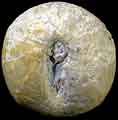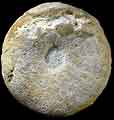The Echinoid Directory
Menopygus Pomel, 1883, p. 52
[=Eogaleropygus Jesionek-Szymnanska, 1978, p. 191, type species Pygaster microstoma Lambert, 1933 ]
| Diagnostic Features |
|
|---|---|
| Distribution | Jurassic (? Pliensbachian, Toarcian-Bajocian), Europe, North Africa. |
| Name gender | masculine |
| Type | Hyboclypus nodoti Cotteau, 1859, p. 52, by original designation. |
| Species Included |
|
| Classification and/or Status |
|
| Remarks | Distinguished from Galeropygus by the complete absence of pore crowding adorally and by its large oblique peristome. Distinguished from Pygaster by its anal sulcus. |




